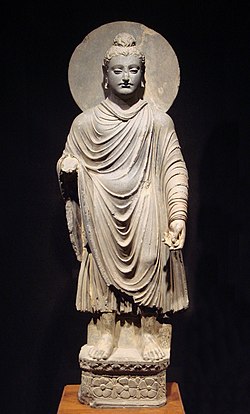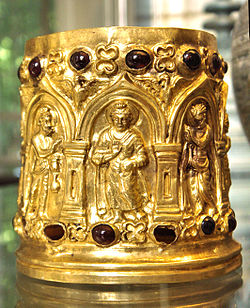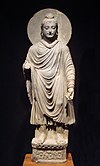Gandhara art
Top: Standing Buddha from Gandhara, 1st-2nd century AD Centre:The Bimaran casket, representing the Buddha, is dated to around 30–10 BC. British Museum; Bottom: The seated Bodhisattva, 2nd century AD, Gandhara, Peshawar Museum. | |
| Years active | 1st century B.C. -5th century A.D. |
|---|---|
| Country | Pakistan, also parts of eastern Afghanistan. |
| Influenced | Buddhist art in Central, East and Southeast Asia. |
Gandhara art or Gandharan art, also known as Greco-Buddhist art, is a blend of Ancient Greek and Buddhist influences that developed mainly in the northwestern regions of Pakistan in the ancient region of Gandhara.[1][2][3] It had influences throughout Central, East and Southeast Asia. The first sculpture of Gautama Buddha in human form was created in this region. The Seated Buddha from Gandhara is the oldest surviving statue of Buddha in the world.[4]
The Gandharan art began with interactions sparked by Alexander the Great's presence and flourished under the Kushan Empire during the 1st-3rd centuries CE. The Gandhara art reached its peak from the 3rd-5th century CE.[5]
Gandhara art features Buddhist themes with a touch of Greco-Roman elements, showcasing a style influenced by Hellenistic art. Notably, it produced the earliest surviving images of Buddha in human form, marking the end of early aniconism (representing Buddha only with symbols) in Buddhism.[6] The realistic portrayal of the human form in large sculptures had a significant impact, spreading Buddhist influence to neighbouring India, Sri Lanka and Afghanistan and as far east as China, Japan, Vietnam and Korea.[7][8][9][10]
References[change | change source]
- ↑ Farooqi, Shazia Tasneem (2018-02-25). "HERITAGE: THE ART OF GANDHARA". DAWN.COM. Retrieved 2023-12-21.
- ↑ "Gandhara art | Greco-Roman, Indian & Buddhist | Britannica". www.britannica.com. Retrieved 2023-12-21.
- ↑ "The Buddhist Heritage of Pakistan: Art of Gandhara". Asia Society. Retrieved 2023-12-21.
- ↑ Krishan, Yuvraj (1996). The Buddha Image: Its Origin and Development. Bharatiya Vidya Bhavan. ISBN 978-81-215-0565-9.
- ↑ "The Art of Gandhara in The Metropolitan Museum of Art - MetPublications - The Metropolitan Museum of Art". www.metmuseum.org. Retrieved 2023-12-21.
- ↑ Foundation, Encyclopaedia Iranica. "Welcome to Encyclopaedia Iranica". iranicaonline.org. Retrieved 2023-12-21.
- ↑ "The Buddhist Heritage of Pakistan: Art of Gandhara". Asia Society. Retrieved 2023-12-21.
- ↑ Ali, Kalbe (2023-07-11). "Monks, scholars reach Islamabad to attend Gandhara symposium". DAWN.COM. Retrieved 2023-12-21.
- ↑ Ali, Kalbe (2023-07-13). "Monks offer rituals at Dharmarajika Stupa, Taxila museum". DAWN.COM. Retrieved 2023-12-21.
- ↑ "Buddhist monks visiting Pakistan from Sri Lanka experience Gandhara's magnificence". Arab News PK. 2021-04-24. Retrieved 2023-12-21.




